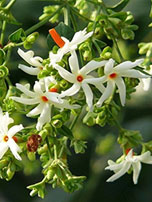SHAHEED KARTAR SINGH SARABHA AYURVEDIC MEDICAL COLLEGE & HOSPITAL
Affiliated to Guru Ravidas Ayurved University, Hoshiarpur Punjab
Affiliated to Guru Ravidas Ayurved University, Hoshiarpur Punjab

Botanical Name : Cestrum nocturnum
Family : Solanaceae
Introduction :
Cestrum nocturnum is a garden shrub from the family Solanaceae, commonly known as “lady of the night” which is used as a remedy for different health disorders. This sprawling shrub has glossy simple leaves, vine like stems, greenish-creamy white tubular flowers and fleshy berries. The berries are marfil white or aubergine in colour. The species name ‘nocturnum’ refers to the species’ habit of opening its small, heavily-scented flowers at night. The flowers release powerful sweet perfume at night. It is made into a rare attar (raat ki rani) which is used in Indian and Middle East perfumery. It is said to be the world’s strongest smelling plant. Indeed the scent can reach up to 165 feet away from the location of plant. The genus name Cestrum is thought to be derived from the Greek word ‘kestron’, for similarity to a plant of that name, or ‘kestrum’, a tool used for engraving, which the plant’s anthers resemble. Like several other members of the Cestrum genus, C. nocturnum is of Neotropical origin. While night blooming jasmine is a gorgeous plant with charming blooms, the scent also produces severe allergic reactions in some individuals.
According to WHO, more than 80% of developing country’s population depends on plant based medicines for their health care needs. From the time immemorial, this shrub is used as a traditional medicine. In India the Malasar people use its juice for cataracts. It contains secondary metabolites such as saponins, flavonoids, cardiac glycosides, alkaloids, steroids and tannins which have biological activity, kindling scientific interest.
Names in different Indian languages :
English : Night Blooming Jasmine, Night-blooming cestrum, Lady of the night
Bengali : Hasna hana
Hindi : Rat ki rani
Kannada : Raatri raani
Konkani : Raatrani
Manipuri : Thabal lei
Marathi : Raatrani
Mizo : Zanlalnu
Synonyms :
Cestrum multiflorum
Cestrum scandens
Distribution :
It is widely cultivated in tropical and subtropical regions of the world.
Morphology :
Night Blooming Jasmine is a sprawling shrub that has glossy, smooth, simple leaves 4-8 inches long. Vine-like stems reach up to 12 ft in its native habitat, but it seldom reaches more than a 4 ft mound in a single season. It blooms in cycles throughout warm weather. Greenish-creamy white tubular flowers rise from above leaves along the stem, followed by shiny white, fleshy berries. Although the flowers are not showy to the eye, their sweet scent can overpower. The perfume is distinctly powerful at night – this feature has had its influence on its common name in all languages. The Hindi name translates to queen of the night, while the Manipuri name means moon flower. No fragrant garden is complete without this nocturnal beauty. While night blooming jasmine is a gorgeous plant with charming blooms, the scent also produces severe allergic reactions in some individuals. Night Blooming Jasmine is native to Mexico to Venezuela, widely cultivated in tropical climates.
Chemical constituents :
Flowers distilled oil contains phenylethyl alcohol (27%), benzyl alcohol (12%), eicosane (5.6%), eugenol (5.6%), n-tetracosane (4.4%), caryophyllene oxide (3.1%), 1-hexadecanol (2.7%), methoxyeugenol (2.45%), benzaldehyde (2.32%). Flowers alcohol extract contains cytotoxic steroids.
Uses :
In traditional medicine, leaves of Cestrum nocturnum have been used for their pharmacological significance in burns and swellings.
It is also used for treating epilepsy.
Pharmacological studies on the plant proved that the leaves have significant analgesic and bactericidal activity.
The volatile oil is known to be mosquito-repellent and hence C. nocturnum is used to prevent malaria in several African Nations.
Local anaesthetic effect, inhibitory effect on central nervous system and cardiac arrthymic effect of plant are also documented. Zhong et al., in 2008 reported that n-butanol and polysaccharide extracts from C. nocturnum has tumor inhibition ability.
